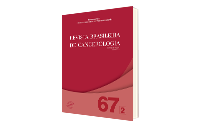Prevalence of Oral Manifestations in Cancer Patients Assisted in a Home Care Program in the City of Pelotas-RS
DOI:
https://doi.org/10.32635/2176-9745.RBC.2021v67n2.1184Keywords:
Dentistry, Dentists, Palliative Care, Medical Oncology, Home NursingAbstract
Introduction: The municipality of Pelotas-RS has the Interdisciplinary Home Internment Program (PIDI) implemented at the Teaching Hospital of the Federal University of Pelotas with the presence of dental surgeons on its team. PIDI assists oncology patients in palliative care. Objective: To evaluate the prevalence of oral manifestations in patients assisted by this program, the epidemiological characteristics of that population and to verify the relationship of the manifestations with the type of cancer and antineoplastic treatment received. Method: Retrospective cross-sectional study with secondary data collected from the dental records of patients seen from April 2018 to September 2019. The Chi-square test was applied, with a 5% significance level (p≤0.05) attributed to significant results. Results: Oral manifestations were found 47 times in the 61 patients evaluated, with some having more than one occurrence. Patients who had primary cancer in the digestive system were the most affected by oral manifestations. The most prevalent oral manifestations were xerostomia (26.2%), followed by candidiasis (18%), mucositis (13.1%), dysphagia and dysgeusia that presented the same percentage (9.8%), no patient developed radiation caries. Xerostomia showed statistical significance (p≤0.05) in relation to the type of cancer. When correlating oral manifestations with the type of treatment received, they were not statistically significant. Conclusion: This study demonstrated a high prevalence of oral manifestations in the population investigated, reaffirming the importance of the dental surgeon in the palliative care multidisciplinary team.









